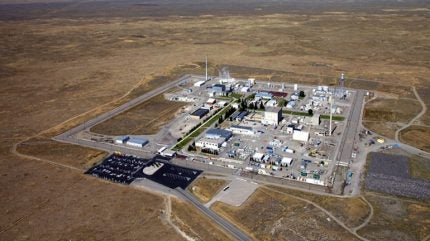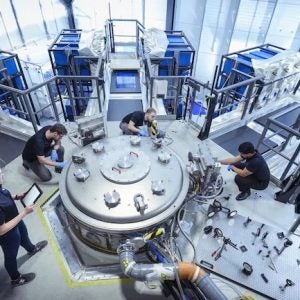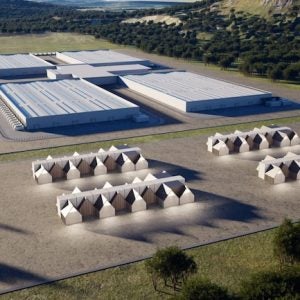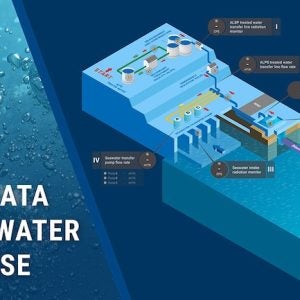
The US Department of Energy (DOE) has released a Request for Information (RFI) to inform possible use of DOE land for artificial intelligence (AI) infrastructure development to support growing demand for data centres. DOE has identified 16 potential sites uniquely positioned for rapid data centre construction, including in-place energy infrastructure with the ability to fast-track permitting for new energy generation such as nuclear.
In accordance with President Trump‘s Removing Barriers to American Leadership in Artificial Intelligence and Unleashing American Energy Executive Orders, DOE is exploring opportunities to accelerate AI and energy infrastructure development across the country, prioritising public-private partnerships to advance the use of innovative technologies and strategies.
“The global race for AI dominance is the next Manhattan project, and with President Trump’s leadership and the innovation of our National Labs, the United States can and will win,” Secretary of Energy Chris Wright said, during a visit to the National Renewable Energy Laboratory (NREL) in Colorado. “With today’s action, the Department of Energy is taking important steps to leverage our domestic resources to power the AI revolution, while continuing to deliver affordable, reliable and secure energy to the American people.”
“President Trump is committed to ensuring American leadership in artificial intelligence and Secretary Wright is delivering,” said White House Office of Science & Technology Policy Director Michael Kratsios. “The Trump Administration will unleash Federal resources to build out the data resources needed for an AI-powered future.”
DOE is seeking input from data centre developers, energy developers, and the broader public. The information collected will be used to inform development, encourage private-public partnerships and enable the construction of AI infrastructure at select DOE sites with a target of commencing operation by the end of 2027.
The sites offer the industry a chance to partner with DOE’s research facilities co-located on the sites, furthering advancements in both the power systems design needed to run the centres and developing next-generation data centre hardware.
The RFI listed the 16 sites and provided information about each in its appendices. The sites are:
- Idaho National Laboratory (INL)
- Paducah Gaseous Diffusion Plant (Paducah)
- Portsmouth Gaseous Diffusion Plant (Portsmouth)
- Argonne National Laboratory (ANL)
- Brookhaven National Laboratory (BNL)
- Fermi National Accelerator Laboratory (FNAL)
- National Energy Technology Laboratory (NETL)
- National Renewable Energy Laboratory (NREL)
- Oak Ridge National Laboratory (ORNL)
- Pacific Northwest National Laboratory (PNNL)
- Princeton Plasma Physics Laboratory (PPPL)
- Los Alamos National Laboratory (LANL)
- Sandia National Laboratories (SNL)
- Savannah River Site (SRS)
- Pantex Plant
- Kansas City National Security Campus
INL is located in a region that is highly supportive of nuclear energy and offers ample opportunity for development and scaling to meet growing needs.
The Paducah site is designed for up to 3GW in the Midcontinent Independent System Operator power market with ongoing remediation for potential development of a data centre
The Portsmouth site is designed for 2.2GW in the PJM Interconnection power market.
ANL could accommodate a 110-acre developable site for a future 1,000 MW AI data park with an early target for operations by 2028. The proposed data centre site sits on the I-55 corridor, a major route southwest of Chicago that carries multiple long-haul fibre optic cables with ultra-low latency connections.
At BNL, the proposed 90+ acre site for the data centre is located within the BNL Discovery Park District, the mission of which is to promote federal and private development to enable technology transfer opportunities.
FNAL develops and supports large-scale data science applications to process and analyse vast amounts of particle physics data. It operates one of the largest data centres serving DOE’s Office of Science and is a lead participant in a second of the five National Quantum Initiative Centers, leading applications of AI/ML in particle and accelerator physics. The site is conveniently located near a commercially available extra high-voltage (EHV) transmission infrastructure. The location also provides potential access to robust data connection infrastructure.
NETL’s Morgantown and Pittsburgh campuses offer excellent potential for hosting frontier AI infrastructure. Both sites are proximal to major universities and academic centres and serve as regional technology and innovation hubs. NETL also conducts applied energy research in AI and that includes advanced computing.
NREL’s Flatiron Campus has enough land, power, water, and broadband capability to host a 100 MW data centre that could be initiated as soon as this year. The site could support an integrated data centre energy system test bed, that could be deployed later at scale at other locations. NREL aims to establish a site where a developer can continue its usual business operations while using the site as a proving ground. NREL has an 11-acre site located just west of the Flatirons main campus that would be an ideal location for a data centre facility.
DOE has federal land available contiguous to ORNL which is well-suited to support the AI Infrastructure initiative within the two-to-three-year goal. The area has utilities anticipated to be sufficient to support the rapid development of an AI data centre. The site is also located approximately 5 miles from the proposed TVA Clinch River small modular reactor (SMR) site, providing opportunity to capitalise on regional nuclear infrastructure up to 800MW in capacity.
PNNL has access to the highly skilled labour needed to construct and operate power generation facilities; and to quickly build the proposed frontier AI data centre. In addition to hydroelectric and conventional nuclear power, SMRs envisioned by energy providers in the region could provide additional power for the data centre.
PPPL and Princeton University (PU) have been at the cutting edge of high-performance computing and AI developments for decades. AI work in the Princeton ecosystem combined with the available land and power infrastructure, make PPPL and PU ideal partners to host an AI data centre. This centre would emphasise accelerating fusion energy development and energy system optimisation, exploit new data that will come from the NSTX-U fusion user facility that will come online in 2026, and foster public-private fusion partnerships. The Forrestal Campus offers a vibrant, cross-cutting ecosystem primed for test-bed development opportunities in AI. The PPPL-PU-AI data centre would also support an eastern hub of AI innovation serving public and private partners in (for example) Pennsylvania, New York, Connecticut, and Massachusetts.
LANL is committed to an enduring on-premises High Performance Computing (HPC) and infrastructure to support its current plan-of-record and expanded AI mission scope. LANL has already responded to calls for on/offsite data centres. LANL is executing an upgrade of the Strategic Computing Complex (SCC) to 70MW, which requires the Electrical Power Capacity Upgrade (EPCU) and the SCC Electrical Upgrade (SEU) GPP; these projects are funded and near start of construction. LANL recognises that the new on-premises commercial data centre would be limited to a total of 100MW for HPC+AI infrastructure.
The National Nuclear Security Administration (NNSA) SNL has locations in Albuquerque, New Mexico; Livermore, California; Kauai, Hawaii; and Tonopah, Nevada. Sandia has currently identified two sites of roughly nine acres each. There may also be a possibility to collaborate with Kirtland Airforce Base (KAFB) for a site, which provides added security for a data centre and infrastructure.
At SRS the footprint of a data centre is very small compared with the 310 square miles of SRS; therefore, a more detailed description of the site requirements is required to select the best locations.
Pantex is the US primary site for assembly and disassembly of nuclear weapons. The preferred site for a data centre is approximately 380 acres of NNSA-owned land. A second area is approximately 5,700 acres currently owned by Texas Tech University (TTU) and leased by NNSA. This could potentially be purchased from TTU but would require a real estate agreement. Any of the farmland located around Pantex could be considered for purchase.
NNSA’s Kansas City National Security Campus is responsible for manufacturing and procuring nonnuclear components for nuclear weapons. The site is surrounded with security fencing and currently enjoys residential power and water support.






